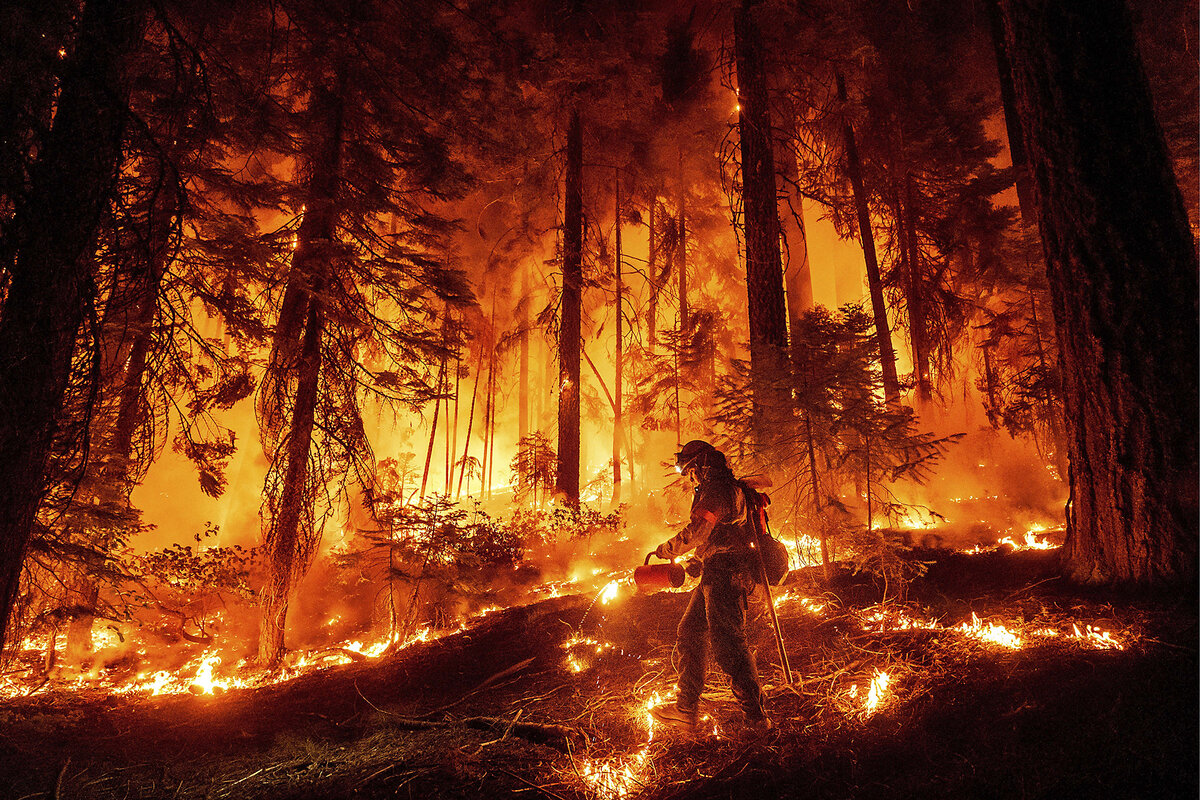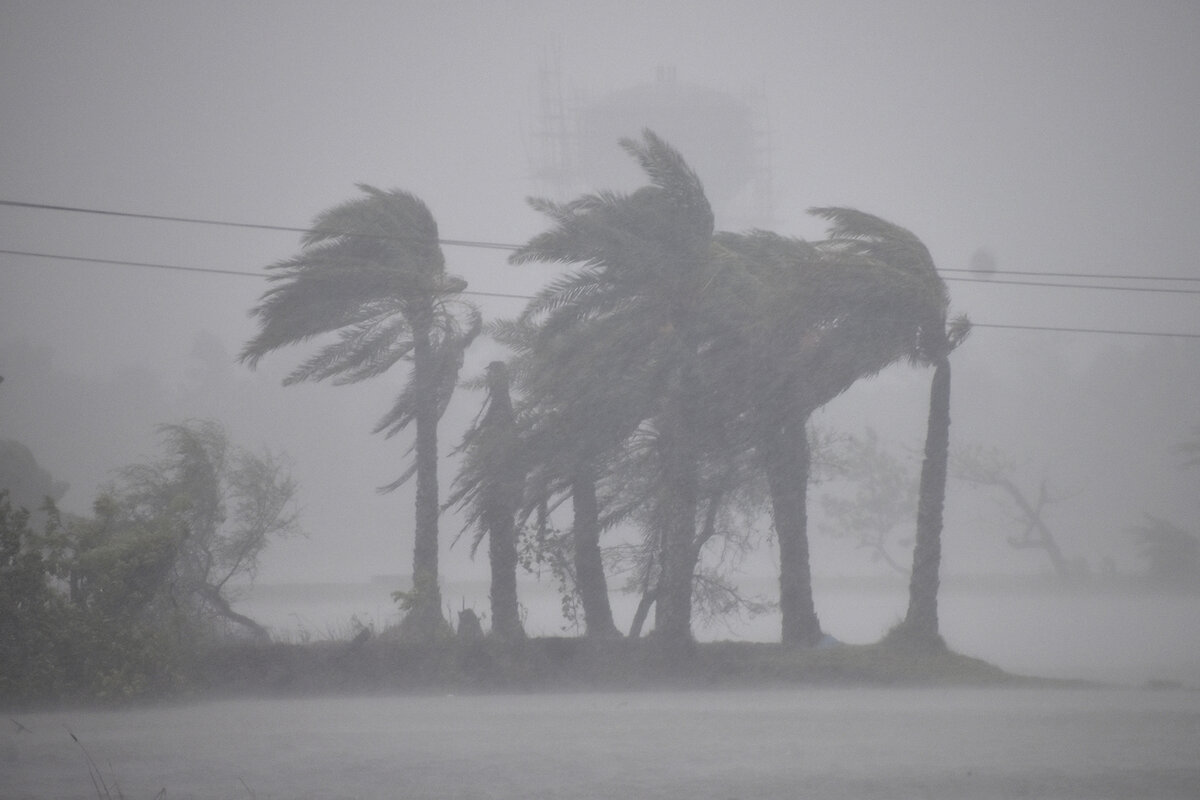Is climate change causing extreme weather? The science is complicated.
Loading...
Floods and tornadoes as storms like Hurricane Francine move inland. Raging wildfires across southern California, which experienced near triple-digit temperatures after Labor Day. An American summer shaping up to be one of the hottest ever – even though August temperatures were relatively temperate.
Is it all because of climate change?
The answer is complicated. Scientists know that humans have made the world hotter, largely by burning fossil fuels like gas and oil. They also agree that more heat – aka energy – in the atmosphere can lead to a host of increasingly intense, and less predictable, weather events.
Why We Wrote This
After a summer of brutal heat waves, hurricanes, and wildfires, it’s easy to assume that extreme weather is linked to climate change. That’s often true, but scientists are still learning more. Their findings impact decision-making in a variety of fields.
But when it comes to connecting any one extreme weather event to climate change, scientists agree that the answer is about likelihoods, not certainties. And within the finer details – how rising temperature will impact California fog, for instance, or how it is impacting the frequency of hurricanes – there are still scientific unknowns and debates.
“We are seeing increases in many types of extreme weather, which is consistent with theory and predictions and modeling,” says Daniel Swain, a climate scientist with the Institute of the Environment and Sustainability at the University of California, Los Angeles. But what that means, he adds, “really does vary by the type of extreme weather we’re talking about.”
This all might seem nuanced, and maybe even like “in the weeds” science. But understanding the details when it comes to climate change and extreme weather – where models work and where they don’t, where human behavior is the main culprit and where we still don’t know – matters tremendously, experts say. It has implications on everything from where houses are built to how to ensure humans have enough food.
“There are certain people in the world, like people who work in insurance and reinsurance, people who build dams and manage water resources, people who plan for hurricane landfalls; they don’t have the luxury of believing whatever they want to believe,” says Roger Pielke Jr., a University of Colorado Boulder professor whose research is cited by the Intergovernmental Panel on Climate Change. “They need to stick to what we can and can’t say with the science.”
Climate change and extreme weather: what scientists know
The clearest information we have about the warming atmosphere is on the global level. The Earth is clearly warmer than it once was, and scientists know – from studying carbon isotopes, historical patterns, and climate modeling – that the reason for this warming is the accumulation of heat-trapping, or greenhouse, gases, primarily from fossil fuels like coal or oil.
But those planetary-wide numbers don’t necessarily say what’s happening in your neighborhood – or let you predict what might happen next month.
Overall, Earth is about 2.45 F warmer now than the average temperature in the preindustrial 19th century. But the global mean temperature can seem abstract, without telling people much about what’s happening on the ground in a particular place and at a particular time, says Dr. Swain.
“The global mean temperature, of course, is not a number that any individual human or animal or plant on Earth ever actually experiences, right?” Dr. Swain says.
Heat waves and climate change: more complicated than you’d think
Even temperature can get complicated. The air over land has warmed faster than over the ocean. Temperature increases happen in both the winters and summers, nighttime and daytime. Throughout the end of the 2024 summer, for instance, the western U.S. did not break high temperature records, but experienced hotter nights than ever before – something that can have significant impact on people and ecosystems.
“If people can’t cool their body temperatures at night, that makes them more susceptible to heat the next day,” says Erinanne Saffell, state climatologist of Arizona. “Heat is cumulative.”
Because of the complex interactions among land and air and ocean, a few degrees of warming in some places can have cascading effects.
This is arguably best understood when it comes to extreme heat – and why a few degrees of warming can result in temperature spikes that go much higher than even the global land surface average. This is because as the temperature increases, the hotter air sucks moisture out of the soil. With less water in the soil, more of the energy from the sun goes to heating the earth as opposed to evaporating moisture. This creates an accelerating feedback cycle, as that hotter earth then heats up the surrounding air even more.
But it’s hard to definitively say if any given heat wave is because of climate change or normal weather fluctuations – and even more so when it comes to storms, wildfires, and droughts. Scientists have connected increasing heat in the atmosphere to more intense hurricanes, for instance. But determining whether a particular storm is a ”climate change storm” takes research, modeling, and analysis.
How “attribution science” helps identify climate’s role
This summer, researchers using a relatively new tool called “attribution science” found that many of the world’s heat waves were made much more likely because of climate change. But it’s important to recognize that attribution science deals in probabilities. So July’s heat in the U.S., for instance, might have been three times more likely in a warmer world, according to attribution science – but it also could have happened without any global warming at all. It would have just been much less likely.
And even if climate change did cause those heat waves, the calculations are about the duration and peak temperatures. Climate change didn’t transform five 70-degree, low-humidity, lovely summer days into the 98-degree steam bath that many Americans experienced this summer. The change is in what scientists call the graph’s “tails”: As peak temperature goes up, hot weather lasts longer.
In the Pacific Northwest, for instance, the heat lingered this year, with Portland, Oregon, seeing multiple three-digit temperature days at the beginning of the school year.
“September is pretty late to be seeing multiple, consecutive 100-degree days” in that region, Dr. Swain said on his Weather West podcast. “The city itself might tie or even break the record for the latest 100 degree day in a calendar year as well as the record for the cumulative numbers days over 100 degree. That’s fairly remarkable given that August was actually cooler than average and featured multiple rain events that were highly unusual.”
The models have variability. Does that mean global warming isn’t to blame?
Still, despite the limitations, attribution science has allowed policymakers and advocates to more quickly, and clearly, identify the climate change fingerprint on events that directly impact humans. The science, says Jeff Masters, a meteorologist and co-founder of Weather Underground, is a remarkable but limited advance. “The tools they use are things we didn’t have 10 years ago,” he says. “But at the same time, they’re very crude tools.”
Attribution models, for instance, compare sea temperatures with and without human-caused climate change, and examine the difference. This provides a bare-bones estimate, says Dr. Masters, but is inconclusive about exactly how much of extreme weather is due to climate change or natural climate variability.
“You can get some crazy extremes ... without climate change,” he says. “So apportioning all that is a heroic task.”
Some who downplay the role of climate change use these unknowns to suggest that global warming isn’t actually causing extreme weather events. But Dr. Masters and many of his colleagues believe that models are underestimating the role of climate change. Just because there is variability, or because human behavior often ignites events like wildfires, it doesn’t diminish the fact that more energy in the atmosphere leads to surprises.
Why it matters: climate disaster preparedness
How we understand the connections between climate change and extreme weather events can impact a slew of individual, economic, and policy choices.
Dr. Pielke’s work, for instance, has found that much of the increase in financial damages regularly attributed to climate change storms is actually a result of more people with more valuable property located along coastlines. Other experts have come to similar conclusions.
“The issue really lies in the fact that humans are in the way, and we’ve built structures in the way of these riskier zones,” says Libby Zemaitis, senior manager for resilience programs and policy at the Center for Climate and Energy Solutions.
After all, wildfires can be beneficial for ecosystems, but devastating when homes and infrastructure are in their paths. Flooding is barely noticed if towns or roads are not in the water’s path.
But given the growing unpredictability of these extreme weather events, and the reality of increased vulnerability, policymakers have a lot of work to do, she and others say. Although it might be impossible to directly tie, with 100% certainty, any series of extreme weather events to climate change, a clear pattern of the unexpected – of floods, heat waves, and fires at unexpected times and in unexpected places – is emerging.
Communities must increasingly prepare for multiple, sequential extreme events – wildfires and landslides, for instance – that a decade or two ago would have been viewed as impossible, says Rebecca Carter, director of climate adaptation and resilience for the global and U.S. climate program at the World Resources Institute. (After all, not so long ago the Pacific Northwest was viewed as a climate haven. In recent years, it has endured triple-digit heat waves.)
That idea that something is going to happen, even if we don’t know exactly what, concerns many climate scientists, even those who are more conservative about wanting to see a lot of proof, and over an extended period of time, before making the connection with specific extreme events.
“Climate change is always going to be a risk management problem,” says Dr. Pielke. “We’re changing the energy balance of the Earth system. It is going to have consequences.”
Editor's note: This story has been updated to include recent extreme weather events and additional material to provide context. A few sentences from the original story, published on Aug. 29, were cut in the interest of brevity.










